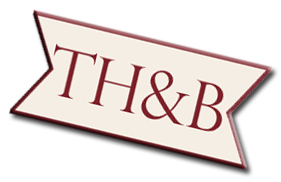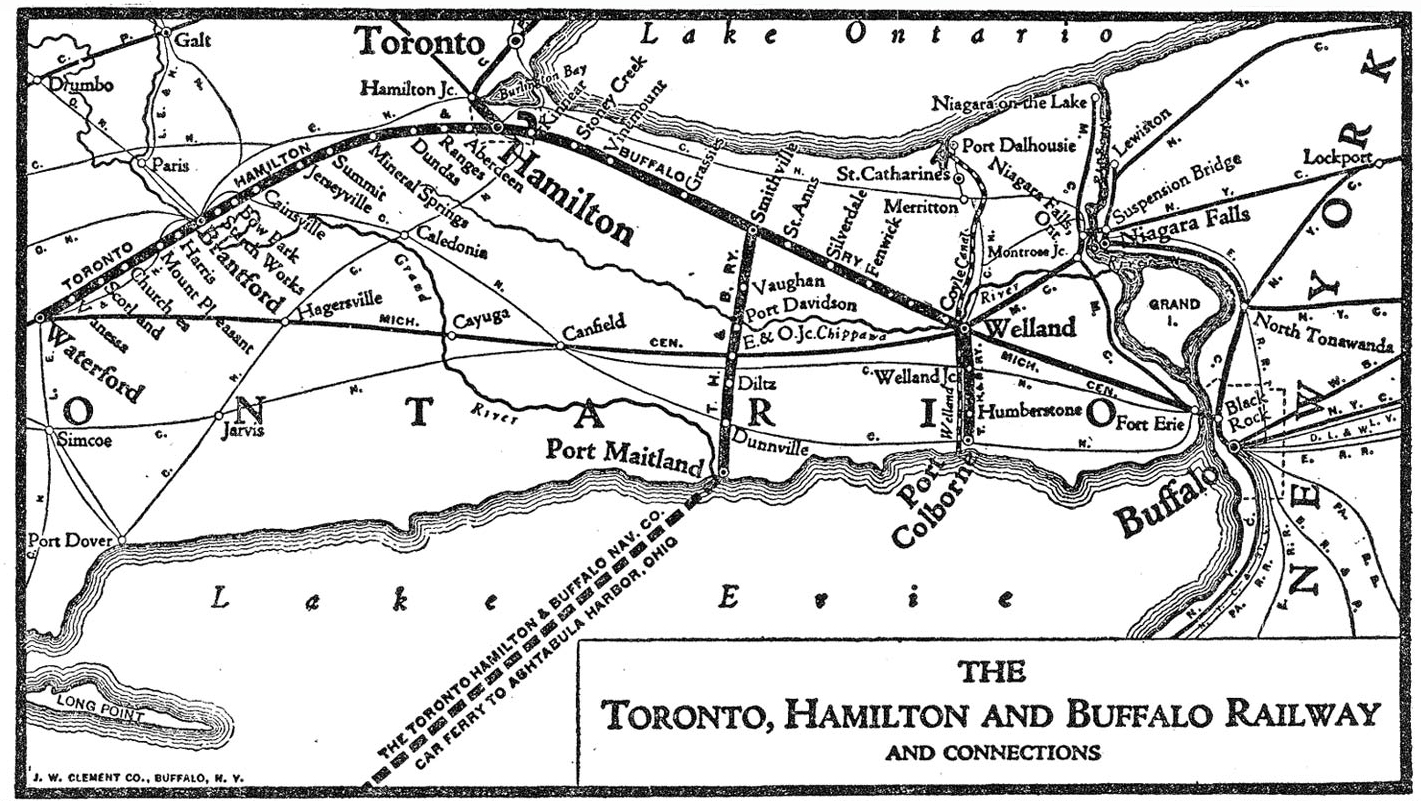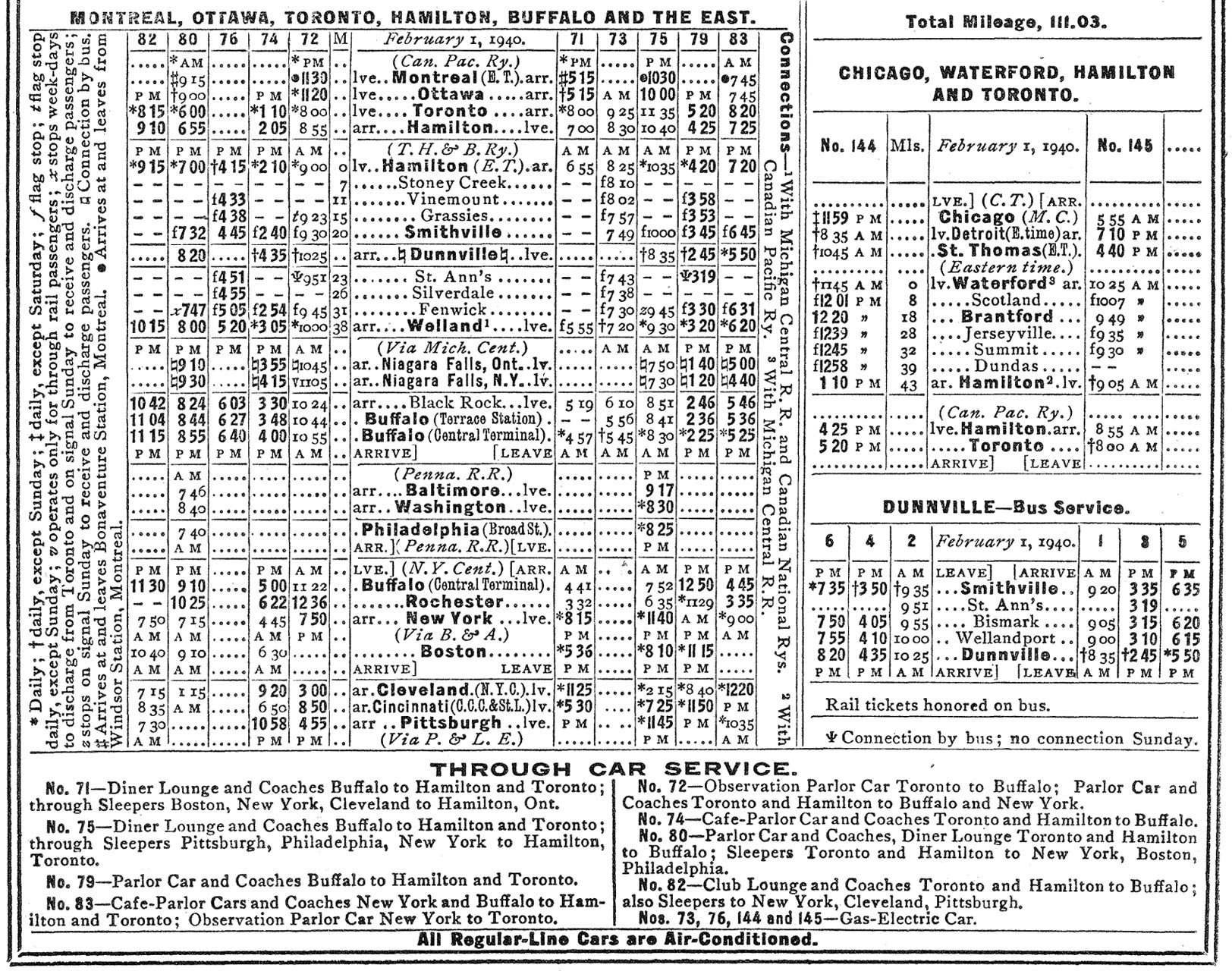Toronto, Hamilton & Buffalo Railway: Map, Roster, History
Last revised: September 4, 2024
By: Adam Burns
Those who live in southern Ontario, or once did, likely remember a
system known as the Toronto, Hamilton & Buffalo Railway (reporting marks, THB).
The company dated to the early 1890s and connected all three of its namesake cities although only one, Hamilton, was actually reached via its own lines.
For much of its operational existence the TH&B was jointly owned between two Class Is, the Canadian Pacific and New York Central, both of which owned their own routes through the region as well.
When the railroad was first chartered it was meant as an alternative for southern Canadian shippers to reach across the Canadian/United States border to Buffalo but its independence lasted only a few years.
Following the failure of the Penn Central in the early 1970s the CP acquired most of the TH&B which spared the line from becoming part of the later Conrail.
While remaining a separate entity for more than a decade, it eventually disappeared into CP in the late 1980s.
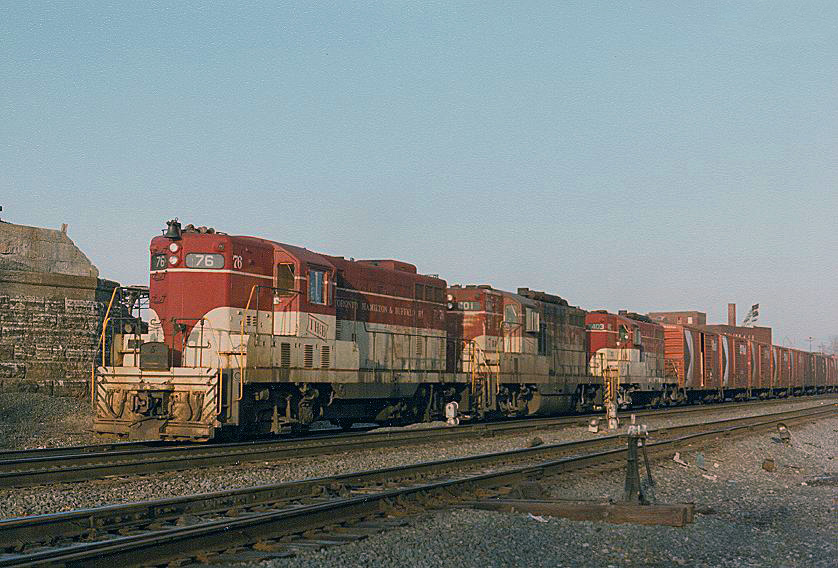 Toronto, Hamilton & Buffalo GP7 #76, along with GP9s #401 and #403, head out of Buffalo's Frontier Yard with westbound freight BUCP on the evening of February 26, 1983. The train is bound for Toronto via trackage rights over Canadian Pacific. Doug Kroll photo.
Toronto, Hamilton & Buffalo GP7 #76, along with GP9s #401 and #403, head out of Buffalo's Frontier Yard with westbound freight BUCP on the evening of February 26, 1983. The train is bound for Toronto via trackage rights over Canadian Pacific. Doug Kroll photo.The Toronto, Hamilton and Buffalo Railway was created by an act of the Ontario Legislative Assembly when it was chartered in 1884.
However, the stipulations of its incorporation required that it could not interchange, lease, or merge with any other railroad, which severely limited the line's viability as a for-profit company.
Interestingly, the TH&B began actual operations by taking over the bankrupt Brantford, Waterloo & Lake Erie Railway in 1892, an 18-mile system that operated between Brantford and Waterford, Ontario located to the west of Hamilton.
In October, 1894 newly constructed tracks totaling 25 miles opened to Hamilton, which became the railroad's headquarters, and the city's leaders declared that the company's continued expansion eastward would use a routing south of the Niagara Escarpment, a mountain-like ridge that split the city in-two.
This section of the TH&B proved to be the toughest from an operational standpoint as its line was forced to climb the ridge out of the city; eastbound moves to Welland (which the railroad reached by December 30, 1895) traversed 1.04% grade, covering 216 feet in only 4.41 miles.
For those westbound trains heading away from Hamilton towards the western terminus of Waterford the climb was a stiffer 1.5%.
By late 1895 the TH&B's route was essentially complete as its purchase by the Canadian Pacific and New York Central that year precluded further expansion to Buffalo or Toronto; it simply used its parents' routes to reach these cities (CP between Hamilton Junction and Toronto and NYC between Welland and Buffalo/Niagara Falls).
The railroad did, however, construct two short branches from its main line; between Smithville and Port Maitland (19 miles in length) as well as from Welland to Port Colborne.
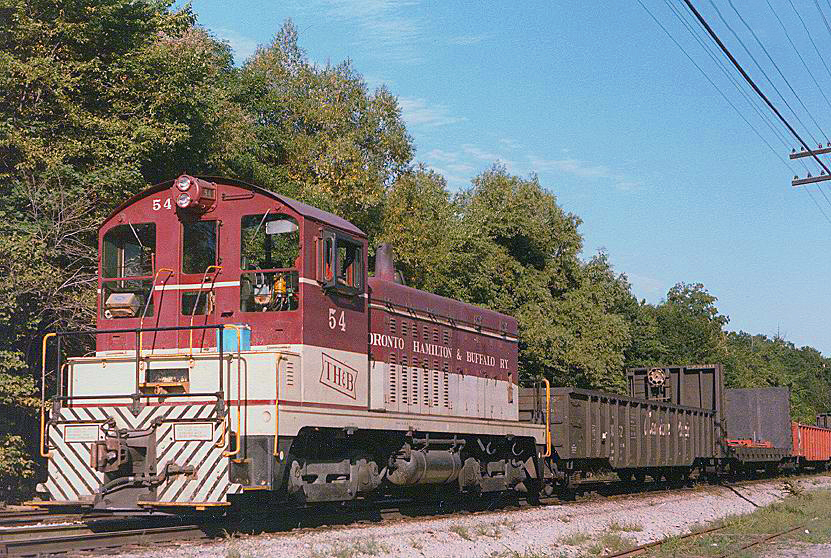 Toronto, Hamilton & Buffalo NW2 #54 moves a cut of cars through Kinnear Yard in Hamilton, Ontario on September 1, 1984. The shortline owned nothing but Electro-Motive products during the diesel era which included Geeps and a few models of switchers. Doug Kroll photo.
Toronto, Hamilton & Buffalo NW2 #54 moves a cut of cars through Kinnear Yard in Hamilton, Ontario on September 1, 1984. The shortline owned nothing but Electro-Motive products during the diesel era which included Geeps and a few models of switchers. Doug Kroll photo.In all, the Toronto, Hamilton and Buffalo Railway's total system was roughly 110 miles in all. During its first thirty years of service standard power included:
- Class G 2-8-0 Consolidations for heavy freight tonnage,
- Class K 4-6-2 Pacifics for passenger runs
- Class F 4-6-0 Ten-wheelers for most other general services
Typically, the TH&B's freight movements headed east into the United States, which meant trains had to battle the grades around Hamilton.
However, by 1925 the 2-8-0s were growing insufficient to lug heavier and heavier freights up and out of the Niagara Escarpment.
It became obvious the larger steamers would be needed but Canadian lines, in general, did not operate wheel arrangements much larger than 2-8-2 Mikados, 2-10-2 Santa Fes, or 2-10-4 Texas Types.
TH&B management was looking at the 2-8-4 Berkshire which was a favorite of parent NYC although the locomotive was not in construction by any Canadian builder.
After comparing an NYC Class H-10 2-8-2 against a Boston & Albany (NYC) Berk, #1433, the TH&B was easily convinced of the latter's superiority.
The railroad was able to likewise convince Alco's Canadian arm, the Montreal Locomotive Works, to acquire the necessary patterns to build two Berkshires which were numbered 201-202 and listed as Class A (the former arrived on June 8, 1928 while the latter was delivered a few days later on June 14).
They were the only 2-8-4s ever used by a Canadian line and could produce 82,000 pounds of tractive effort, nearly twice the capability of the Consolidations' 45,780 pounds.
The Berks were also powerful enough that the TH&B always kept one on standby while the other was in service.
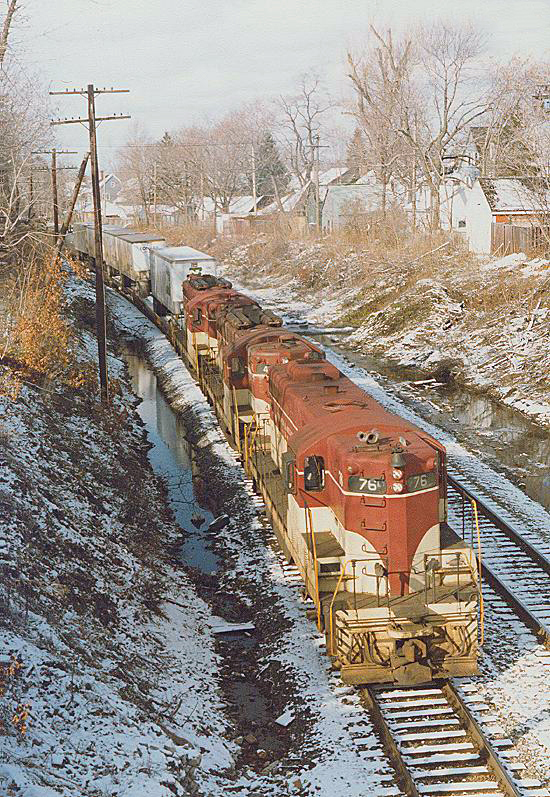 Toronto, Hamilton & Buffalo GP7 #76 along with GP9's #401 and #403 head east on Conrail's Belt Line with train CPBU as they pass beneath the bridge at the corner of Amherst and Starin Avenue in Buffalo, New York on November 27, 1982. Doug Kroll photo.
Toronto, Hamilton & Buffalo GP7 #76 along with GP9's #401 and #403 head east on Conrail's Belt Line with train CPBU as they pass beneath the bridge at the corner of Amherst and Starin Avenue in Buffalo, New York on November 27, 1982. Doug Kroll photo.Surprisingly, the Toronto, Hamilton and Buffalo Railway operated a successful passenger business for many years as its route was the fastest and shortest connection between Toronto and New York's major cities.
For instance, even by the late 1940s the TH&B was carrying more than 500,000 passengers annually.
During the steam era these trains, like the Ontarian (which had connects from Toronto to Buffalo/New York/Rochester/Boston/Cleveland), were usually powered not only by the 4-6-2s mentioned above but also secondhand 4-6-4 Hudsons purchased from the NYC (Class J).
Between November, 1953 and March, 1954 the TH&B's entire steam fleet was slowly retired, replaced by Electro-Motive Geeps and switchers.
After the collapse of the Penn Central the failed company was forced to sell its 73% (that included NYC's 27% and its subsidiaries Michigan Central and Canada Southern that owned 18% each) to pay off its bankruptcy with CP acquiring this in 1977.
Diesel Roster
| Builder | Model Type | Road Number | Notes | Quantity |
|---|---|---|---|---|
| EMD | NW2 | 51-54 | Acquired new: January, 1948. | 4 |
| EMD | SW9 | 55-58 | Acquired new: December, 1950 to January, 1951. | 4 |
| EMD | GP7 | 71-77 | Acquired new: September, 1950 to July, 1953. | 7 |
| EMD | GP9 | 401-403 | Acquired new: January, 1954. | 3 |
(Thanks to Norman S. Helm's "Canada's Only 2-8-4s" from the June, 1985 issue of Trains as a reference for this article.)
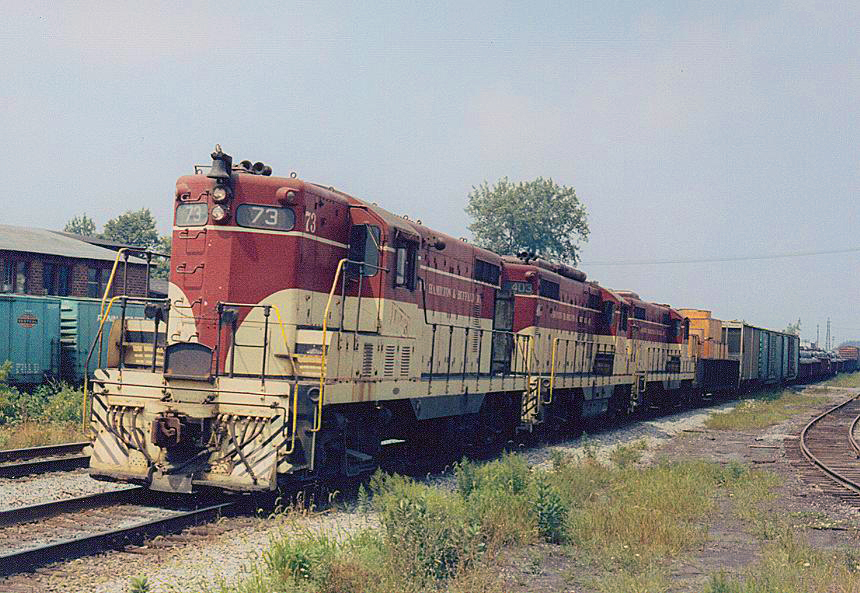 Running on the Penn Central at North Tonawanda, New York a trio of TH&B Geeps lead a southbound freight on August 15, 1973. Doug Kroll photo.
Running on the Penn Central at North Tonawanda, New York a trio of TH&B Geeps lead a southbound freight on August 15, 1973. Doug Kroll photo.Into the 1980s the Toronto, Hamilton and Buffalo Railway was still moving a wide variety of freight (despite its cessation of passenger services after April 26, 1981) that included:
- Auto parts
- Acid
- Fertilizer
- Fencing
- Agriculture
- Farming products
- Steel
- Paper
- Lumber
- Pipe
- Tires
- Tin cans
Combined, this freight provided the TH&B with more than 60,000 carloads annually (quite impressive for a line of its size, particularly during those turbulent years of the industry).
In an effort to streamline its Canadian operations the CP dissolved the TH&B effective January 1, 1987.
To learn more about this classic Ontario system and its history
please check out the Toronto, Hamilton And Buffalo Railway Historical Society's website.
Recent Articles
-
Michigan Dinner Train Rides In Owosso!
Jan 15, 26 09:46 AM
The Steam Railroading Institute is best known as the home of Pere Marquette #1225 and even occasionally hosts a dinner train! -
Arizona's - Wine Tasting - Train Rides
Jan 14, 26 02:04 PM
For those who want to experience the charm of Arizona's wine scene while embracing the romance of rail travel, wine tasting train rides offer a memorable journey through the state's picturesque landsc… -
Arkansas's - Wine Tasting - Train Rides
Jan 14, 26 01:57 PM
This article takes you through the experience of wine tasting train rides in Arkansas, highlighting their offerings, routes, and the delightful blend of history, scenery, and flavor that makes them so… -
Tennessee ~ Murder Mystery ~ Dinner Train Rides
Jan 14, 26 01:42 PM
Amidst the rolling hills and scenic landscapes of Tennessee, an exhilarating and interactive experience awaits those with a taste for mystery and intrigue. -
California ~ Murder Mystery ~ Dinner Train Rides
Jan 14, 26 01:26 PM
When it comes to experiencing the allure of crime-solving sprinkled with delicious dining, California's murder mystery dinner train rides have carved a niche for themselves among both locals and touri… -
Illinois ~ Murder Mystery ~ Dinner Train Rides
Jan 14, 26 01:13 PM
Among Illinois's scenic train rides, one of the most unique and captivating experiences is the murder mystery excursion. -
Vermont's - Murder Mystery - Dinner Train Rides
Jan 14, 26 12:57 PM
There are currently murder mystery dinner trains offered in Vermont but until recently the Champlain Valley Dinner Train offered such a trip! -
Massachusetts Dinner Train Rides On Cape Cod!
Jan 14, 26 12:20 PM
The Cape Cod Central Railroad (CCCR) has carved out a special niche by pairing classic New England scenery with old-school hospitality, including some of the best-known dining train experiences in the… -
Maine Dinner Train Rides In Portland!
Jan 14, 26 11:31 AM
While this isn’t generally a “dinner train” railroad in the traditional sense—no multi-course meal served en route—Maine Narrow Gauge does offer several popular ride experiences where food and drink a… -
Kentucky Dinner Train Rides In Bardstown!
Jan 13, 26 01:14 PM
The essence of My Old Kentucky Dinner Train is part restaurant, part scenic excursion, and part living piece of Kentucky rail history. -
Kansas Dinner Train Rides In Abilene!
Jan 13, 26 12:44 PM
If you’re looking for a heritage railroad that feels authentically Kansas—equal parts prairie scenery, small-town history, and hands-on railroading—the Abilene & Smoky Valley Railroad (A&SV) delivers. -
Michigan ~ Murder Mystery ~ Dinner Train Rides
Jan 13, 26 11:24 AM
Among the lesser-known treasures of this state are the intriguing murder mystery dinner train rides—a perfect blend of suspense, dining, and scenic exploration. -
Virginia's - Murder Mystery - Dinner Train Rides
Jan 13, 26 11:11 AM
Among the state's railroad attractions, murder mystery dinner trains stand out as a captivating fusion of theatrical entertainment, fine dining, and scenic travel. -
Arizona Dinner Train Rides At The Grand Canyon!
Jan 13, 26 10:59 AM
While the Grand Canyon Railway does not offer a true, onboard dinner train experience it does offer several upscale options and off-train dining. -
Georgia Dinner Train Rides In Nashville!
Jan 13, 26 10:27 AM
If you’ve ever wished you could slow down, trade traffic for jointed rail, and let a small-town landscape roll by your window while a hot meal is served at your table, the Azalea Sprinter delivers tha… -
Indiana Valentine's Train Rides
Jan 12, 26 04:27 PM
If you’ve ever wished you could step into a time when passenger trains were a Saturday-night treat and a whistle echoing across farm fields meant “adventure,” the Nickel Plate Express delivers that fe… -
Ohio Valentine's Train Rides!
Jan 12, 26 04:20 PM
The Hocking Valley Scenic Railway offers one of the region’s most atmospheric ways to experience the Hocking Hills area: from the rhythmic click of jointed rail to the glow of vintage coaches rolling… -
Wisconsin's - Wine Tasting - Train Rides
Jan 12, 26 03:10 PM
Wisconsin might not be the first state that comes to mind when one thinks of wine, but this scenic region is increasingly gaining recognition for its unique offerings in viticulture. -
California's - Wine Tasting - Train Rides
Jan 12, 26 02:34 PM
This article explores the charm, routes, and offerings of these unique wine tasting trains that traverse California’s picturesque landscapes. -
Wisconsin Scenic Train Rides In North Freedom!
Jan 12, 26 02:20 PM
The Mid-Continent Railway Museum is a living-history museum built around the sights, sounds, and everyday rhythms of small-town and shortline railroading in the early 20th century, what the museum cal… -
Vermont Scenic Train Rides In Burlington!
Jan 12, 26 01:18 PM
Today, GMRC is best known by many travelers for its Burlington-based passenger experiences—most famously the Champlain Valley Dinner Train and the sleek, limited-capacity Cocktails on the Rails. -
Maryland's - Murder Mystery - Dinner Train Rides
Jan 12, 26 01:03 PM
Maryland is known for its scenic landscapes, historical landmarks, and vibrant culture, but did you know that it’s also home to some of the most thrilling murder mystery dinner trains? -
Minnesota's - Murder Mystery - Dinner Train Rides
Jan 12, 26 12:17 PM
Murder mystery dinner trains offer an enticing blend of suspense, culinary delight, and perpetual motion, where passengers become both detectives and dining companions on an unforgettable journey. -
Vermont Dinner Train Rides In Burlington!
Jan 12, 26 12:09 PM
There is one location in Vermont hosting a dedicated dinner train experience at the Green Mountain Railroad. -
Connecticut Dinner Train Rides In Essex!
Jan 12, 26 10:39 AM
Connecticut's rail heritage can be traced back to the industry's earliest days and a few organizations preserve this rich history by offering train rides. The Essex Steam Train also hosts dinner-theme… -
Florida Scenic Train Rides In Parrish!
Jan 11, 26 10:26 PM
The Florida Railroad Museum (FRRM) in Parrish offers something increasingly rare in today’s rail landscape: a chance to ride historic equipment over a surviving fragment of an early-20th-century mainl… -
California's - Wine Tasting - Train Rides
Jan 11, 26 02:28 PM
This article explores the charm, routes, and offerings of these unique wine tasting trains that traverse California’s picturesque landscapes. -
Georgia's - Murder Mystery - Dinner Train Rides
Jan 11, 26 02:07 PM
In the heart of the Peach State, a unique form of entertainment combines the thrill of a murder mystery with the charm of a historic train ride. -
Colorado ~ Murder Mystery ~ Dinner Train Rides
Jan 11, 26 01:43 PM
Nestled among the breathtaking vistas and rugged terrains of Colorado lies a unique fusion of theater, gastronomy, and travel—a murder mystery dinner train ride. -
Minnesota Dinner Train Rides In Duluth!
Jan 11, 26 01:32 PM
One of the best ways to feel the region's history in motion today is aboard the North Shore Scenic Railroad (NSSR), which operates out of Duluth’s historic depot. -
Illinois Dinner Train Rides At Monticello!
Jan 11, 26 12:42 PM
The Monticello Railway Museum (MRM) is one of those places that quietly does a lot: it preserves a sizable collection, maintains its own operating railroad, and—most importantly for visitors—puts hist… -
Alabama's - Wine Tasting - Train Rides
Jan 10, 26 09:29 AM
While the state might not be the first to come to mind when one thinks of wine or train travel, the unique concept of wine tasting trains adds a refreshing twist to the Alabama tourism scene. -
Maryland Dinner Train Rides At WMSR!
Jan 10, 26 09:13 AM
The Western Maryland Scenic Railroad (WMSR) has become one of the Mid-Atlantic’s signature heritage operations—equal parts mountain railroad, living museum, and “special-occasion” night out. -
Arkansas Dinner Train Rides On The A&M!
Jan 10, 26 09:11 AM
If you want a railroad experience that feels equal parts “working short line” and “time machine,” the Arkansas & Missouri Railroad (A&M) delivers in a way few modern operations can. -
South Dakota's - Murder Mystery - Dinner Train Rides
Jan 10, 26 09:08 AM
While the state currently does not offer any murder mystery dinner train rides, the popular "1880 Train" at the Black Hills Central recently hosted these popular trips! -
Wisconsin's - Murder Mystery - Dinner Train Rides
Jan 10, 26 09:07 AM
Whether you're a fan of mystery novels or simply relish a night of theatrical entertainment, Wisconsin's murder mystery dinner trains promise an unforgettable adventure. -
Missouri's - Murder Mystery - Dinner Train Rides
Jan 10, 26 09:05 AM
Missouri, with its rich history and scenic landscapes, is home to one location hosting these unique excursion experiences. -
Washington ~ Murder Mystery ~ Dinner Train Rides
Jan 10, 26 09:04 AM
This article delves into what makes murder mystery dinner train rides in Washington State such a captivating experience. -
Kentucky Scenic Train Rides At KRM!
Jan 09, 26 11:13 PM
Located in the small town of New Haven the Kentucky Railway Museum offers a combination of historic equipment and popular excursions. -
Washington "Wine Tasting" Train Rides
Jan 09, 26 08:53 PM
Here’s a detailed look at where and how to ride, what to expect, and practical tips to make the most of wine tasting by rail in Washington. -
Kentucky's - Wine Tasting - Train Rides
Jan 09, 26 08:21 PM
Kentucky, often celebrated for its rolling pastures, thoroughbred horses, and bourbon legacy, has been cultivating another gem in its storied landscapes; enjoying wine by rail. -
Kentucky's - Murder Mystery - Dinner Train Rides
Jan 09, 26 01:12 PM
In the realm of unique travel experiences, Kentucky offers an enchanting twist that entices both locals and tourists alike: murder mystery dinner train rides. -
Utah's - Murder Mystery - Dinner Train Rides
Jan 09, 26 01:05 PM
This article highlights the murder mystery dinner trains currently avaliable in the state of Utah! -
North Carolina Dinner Train Rides At NCTM!
Jan 09, 26 12:51 PM
Tucked into the Piedmont town of Spencer, the North Carolina Transportation Museum is the kind of place that feels less like a typical museum and more like a living rail yard that never quite stopped… -
Tennessee Dinner Train Rides At The TVRM!
Jan 09, 26 12:39 PM
Tucked into East Chattanooga, the Tennessee Valley Railroad Museum (TVRM) is less a “museum you walk through” and more a railroad you step aboard. -
New York Scenic Train Rides On The A&A!
Jan 09, 26 11:20 AM
The A&A is both a common-carrier short line moving freight and a heritage railroad hosting popular excursion trains, all on the same storied right-of-way. -
Pennsylvania Scenic Train Rides In Hollidaysburg!
Jan 09, 26 11:14 AM
Tucked into the Juniata River valley just south of Altoona, the Everett Railroad offers one of the most approachable—and photogenic—heritage-rail experiences in Pennsylvania -
Montana Dinner Train Rides Near Lewistown!
Jan 08, 26 03:03 PM
The Charlie Russell Chew Choo turns an ordinary rail trip into an evening event: scenery, storytelling, live entertainment, and a hearty dinner served as the train rumbles across trestles and into a t… -
Alabama's - Murder Mystery - Dinner Train Rides
Jan 08, 26 02:19 PM
There is currently one location in the state offering a murder mystery dinner experience, the Wales West Light Railway! -
Rhode Island's - Murder Mystery - Dinner Train Rides
Jan 08, 26 01:43 PM
Let's dive into the enigmatic world of murder mystery dinner train rides in Rhode Island, where each journey promises excitement, laughter, and a challenge for your inner detective.

